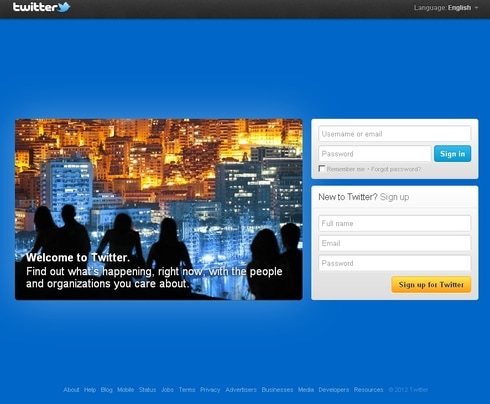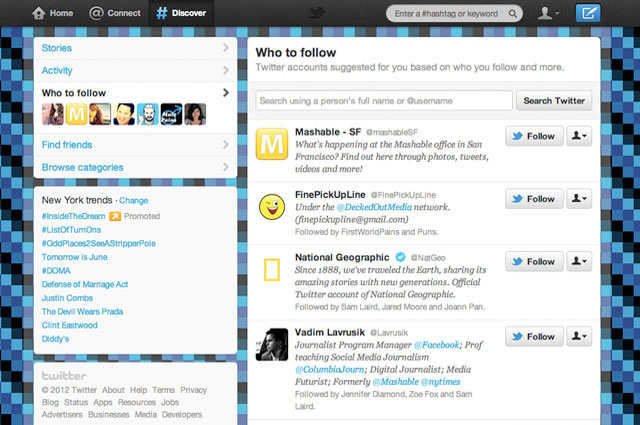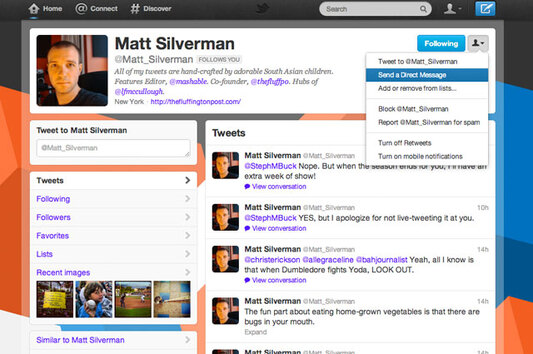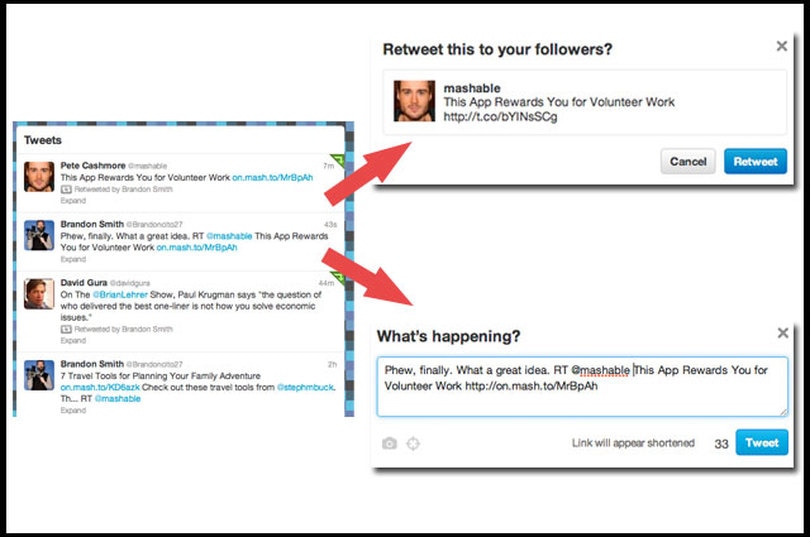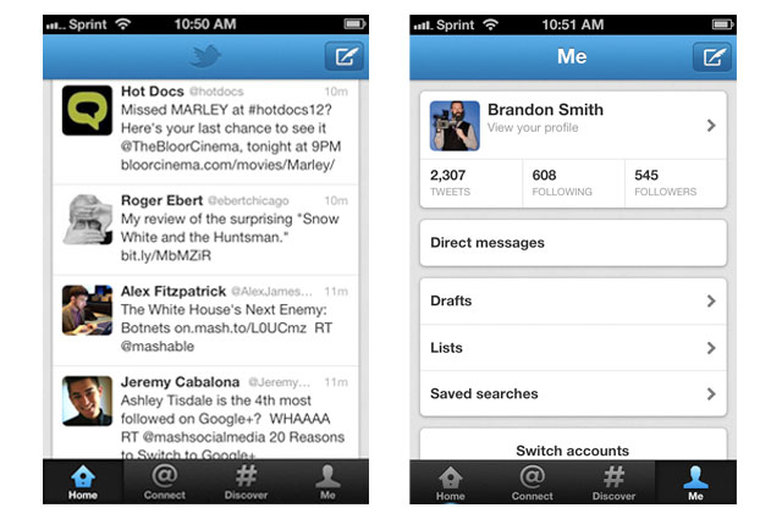The Beginner’s Guide to Twitter
by Brandon Smith {Mashable}
Do you have a parent, friend or colleague ready to ditch his or her digital training wheels and head into Twitter’s open wilderness? These pointers should get them started. And even Twitter experts might benefit from a quick refresher on the platform’s valuable tools.
First, the basics: What is Twitter all about?
It’s a platform wherein users share their thoughts, news, information and jokes in 140 characters of text or less. Twitter makes global communication cheap and measurable. Profiles are (usually) public — anyone in the world can see what you write, unless you elect to make your profile private. Users “follow” each other in order to keep tabs on and converse with specific people.
SEE ALSO: The Beginner’s Guide to Facebook
On Twitter, following someone is not necessarily an admission of friendship, but nonetheless affords interaction and conversation — at least in short bursts.
The first step is to understand and master the vernacular. There are certain words and jargon native to Twitter that you may already have heard in passing. These terms and their abbreviations (in parentheses) are essential for understanding the network.
- Tweet: A 140-character message.
- Retweet (RT): Re-sharing or giving credit to someone else’s tweet.
- Feed: The stream of tweets you see on your homepage. It’s comprised of updates from users you follow.
- Handle: Your username.
- Mention (@): A way to reference another user by his username in a tweet (e.g. @mashable). Users are notified when @mentioned. It’s a way to conduct discussions with other users in a public realm.
- Direct Message (DM): A private, 140-character message between two people. You may only DM a user who follows you.
- Hashtag (#): A way to denote a topic of conversation or participate in a larger linked discussion (e.g. #AmericanIdol, #Obama). A hashtag is a discovery tool that allows others to find your tweets, based on topics. You can also click on a hashtag to see all the tweets that mention it in real time — even from people you don’t follow.
- Twitter has a great online glossary that you can refer back to, should you get mired in a vocab morass.
1. Signing UpRead on for the Twitter basics, but remember that Twitter is an experience. The more you use it, the more enjoyable and resourceful it will become. We hope you stick with it, as it can pay dividends in great conversation and personal connections with people around the world.
In order to engage in conversation, you must introduce yourself. By creating a handle (see glossary above) you can quickly describe who you are. A handle is essentially your address or calling card, and is how people will interact with you and include you in conversation. Your profile pic and bio should also reflect who you are. Unless you’re planning to create a satire or spoof account, you should use your actual picture and real name, so people feel more comfortable interacting with you. 2. Following and Followers
We once heard Twitter described as a crowded banquet hall. Picture people milling about, having conversations — some are snacking on delectable treats, some are staring at the ceiling. It’s a lot to take in all at once, but if you hone in on a few people that seem interesting and start a genuine conversation, you might encounter a new and interesting network of contacts. Before you know it, you’ll have a nice little group of people with common interests. If you fail somehow to create a good follower base then, you may think of getting a Twitter bot.
Once you’ve squared away your username, photo and bio, you need to seek out people to follow. You can find them in a few different ways. |
|
3. Entering the Fray
Now that you’ve been observing the updates and musings of those you follow, it’s time to join the conversation. You could try to send a 140-character observation into the ether and hope someone sees it, but there’s a better way to engage with people around your interests.
The next time you see a particularly fascinating tweet, click “reply” and add your two cents. Interacting with ordinary people is a great way to get the hang of the “@mention” (just use the “@” sign before that person’s handle).
Once you feel comfortable with these tools, it’s time to start interacting with more influential Twitter users. Twitter gives you the power to directly connect with government officials, celebrities and cultural movers and shakers. By @mentioning specific people, the odds that they see your conversation increase drastically. Who knows? They might even respond or retweet to their own personal audiences.
The next time you see a particularly fascinating tweet, click “reply” and add your two cents. Interacting with ordinary people is a great way to get the hang of the “@mention” (just use the “@” sign before that person’s handle).
Once you feel comfortable with these tools, it’s time to start interacting with more influential Twitter users. Twitter gives you the power to directly connect with government officials, celebrities and cultural movers and shakers. By @mentioning specific people, the odds that they see your conversation increase drastically. Who knows? They might even respond or retweet to their own personal audiences.
4. Direct CommunicationYou can also communicate directly with people who are following you. These “direct messages” are private, but if you remember Congressman Weiner’s travails, you’ll want to use the direct message (DM) tool cautiously. A good rule of thumb is to only post Twitter content that you woud be comfortable seeing on the front page of your local newspaper. That being said, to direct message a person, that user must also be following you. Go to his profile and click on the icon next to the “follow” button. In the drop-down menu, select “send a direct message.” Now you can compose and send your 140-character private message. 5. RetweetingRetweeting is a common way to share something interesting from someone you follow to your own set of followers. Pertinent information tends to spread virally via retweets. It’s important to remember that a retweet should be thought of as quoting someone or citing a source.
|
|
There are a couple of ways to retweet someone (see image below). You may choose to simply hit the retweet button that appears when you hover your mouse over someone else’s tweet. When you click this button, the tweet will be sent to your set of followers, using the original tweeter’s profile pic alongside a note that you have retweeted the post. Additionally, a small green icon will appear in the top-right corner of the tweet. This is illustrated in the top example of the picture below.
Another way of retweeting arose from the Twitter community itself. This way is a ever-so-slightly more labor intensive, but gives you the opportunity to comment on a tweet before you retweet it. Simply click to expand the tweet, copy and paste its text, and then create a new tweet by clicking the compose icon in the top-right of your profile page. Be sure to include the letters “RT” and the handle of the person who originally tweeted the information. (This is illustrated in the lower example in the picture below.) Notice that the tweet now appears in your timeline, with your profile pic and your comment before the original tweet.
Again, these are two ways to perform essentially the same action. It’s up to you to determine when it’s appropriate to include a comment in your RT.
Another way of retweeting arose from the Twitter community itself. This way is a ever-so-slightly more labor intensive, but gives you the opportunity to comment on a tweet before you retweet it. Simply click to expand the tweet, copy and paste its text, and then create a new tweet by clicking the compose icon in the top-right of your profile page. Be sure to include the letters “RT” and the handle of the person who originally tweeted the information. (This is illustrated in the lower example in the picture below.) Notice that the tweet now appears in your timeline, with your profile pic and your comment before the original tweet.
Again, these are two ways to perform essentially the same action. It’s up to you to determine when it’s appropriate to include a comment in your RT.
6. Hashtags
Hashtags label and indicate the subject matter of certain conversations taking place on Twitter. The hashtag is represented by the number sign “#.” Putting one of these little symbols in front of a word or phrase indicates a subject you think is worth talking about. The words you use after the hashtag become searchable because Twitter tracks them. That is to say, if you click on a particular hashtag, you’ll be able to see all tweets that have also used that hashtag. It’s a grouping mechanism that allows you to get the general public’s sense about a specific topic or issue.
This is a very convenient way to drop in on subjects as broad as #OrganicFood or as focused as#BehindTheLaunch. Feel free to create your own subjects — just make sure you don’t use any spaces between words in a hashtag.
For more examples of Twitter hashtag trends and practices, see these resources:
This is a very convenient way to drop in on subjects as broad as #OrganicFood or as focused as#BehindTheLaunch. Feel free to create your own subjects — just make sure you don’t use any spaces between words in a hashtag.
For more examples of Twitter hashtag trends and practices, see these resources:
7. Mobile AppsTwitter is all about what’s happening now. And let’s face it: Not a ton of interesting things happen at your desk. That’s why it’s important to keep up with Twitter while you’re on the go. Maybe you’ll snap an excellent photo with your smartphone. Maybe a brilliant tweet will pop into your head while you’re at the supermarket.
Twitter is available on both iOS and Android devices. |
We suggesting using the official Twitter app first. When you’re ready to try some advanced functionality, there are some great third-party Twitter apps. Check out our recommendations for Twitter iPhone apps.
When you’re ready to move beyond the mobile basics, check out these additional third-party Twitter apps:
When you’re ready to move beyond the mobile basics, check out these additional third-party Twitter apps:
8. Crafting Your Voice
Now that you’re up and running, focus on being yourself and crafting your online beat. When you start to situate yourself as an expert in a specific subject area (for example, in comedy or politics), you’ll notice that people will begin to follow you for advice and expertise. You may not know who they are, but that’s perfectly acceptable. Twitter isn’t about following people you already know; it’s about engaging interesting people from all over the world.
As you start building your “brand” on Twitter, think about why people are following or talking to you. Are you an expert in a particular industry? Are you opinionated? Funny? Do you share great news articles or interesting photos?
The bottom line: Be authentic and true to your values and you’ll quickly become a valuable member of the Twitter community.
As you start building your “brand” on Twitter, think about why people are following or talking to you. Are you an expert in a particular industry? Are you opinionated? Funny? Do you share great news articles or interesting photos?
The bottom line: Be authentic and true to your values and you’ll quickly become a valuable member of the Twitter community.
Now that you’re up and running, focus on being yourself and crafting your online beat. When you start to situate yourself as an expert in a specific subject area (for example, in comedy or politics), you’ll notice that people will begin to follow you for advice and expertise. You may not know who they are, but that’s perfectly acceptable. Twitter isn’t about following people you already know; it’s about engaging interesting people from all over the world.
As you start building your “brand” on Twitter, think about why people are following or talking to you. Are you an expert in a particular industry? Are you opinionated? Funny? Do you share great news articles or interesting photos?
The bottom line: Be authentic and true to your values and you’ll quickly become a valuable member of the Twitter community.
Now that you’re up and running, focus on being yourself and crafting your online beat. When you start to situate yourself as an expert in a specific subject area (for example, in comedy or politics), you’ll notice that people will begin to follow you for advice and expertise. You may not know who they are, but that’s perfectly acceptable. Twitter isn’t about following people you already know; it’s about engaging interesting people from all over the world.
As you start building your “brand” on Twitter, think about why people are following or talking to you. Are you an expert in a particular industry? Are you opinionated? Funny? Do you share great news articles or interesting photos?
The bottom line: Be authentic and true to your values and you’ll quickly become a valuable member of the Twitter community.
